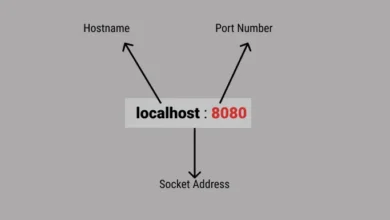Comprehensive Article on “127.0.0.1:49342”

Introduction to 127.0.0.1:49342
127.0.0.1:49342 represents a specific way of addressing your computer within a network using the localhost IP address and a designated port number. This unique combination is vital for various applications in network testing, development, and internal communication. Understanding how it works, its significance, and how to configure and troubleshoot it is essential for IT professionals and developers alike.
Understanding IP Addresses
IP addresses are numerical labels assigned to each device connected to a computer network that uses the Internet Protocol for communication. They serve two main functions: identifying the host or network interface and providing the location of the host in the network.
IPv4 vs. IPv6: IPv4 is the fourth version of the Internet Protocol, using a 32-bit address scheme allowing for over 4 billion unique addresses. IPv6, the latest version, uses 128-bit addresses, significantly increasing the number of possible addresses and addressing the limitations of IPv4.
Structure: An IPv4 address consists of four numbers separated by periods, each ranging from 0 to 255 (e.g., 192.168.1.1). IPv6 addresses are represented as eight groups of four hexadecimal digits separated by colons (e.g., 2001:0db8:85a3:0000:0000:8a2e:0370:7334).
Purpose: IP addresses are crucial for routing data across networks, ensuring that information sent from one computer reaches the correct destination.
The Role of Localhost
Definition: Localhost refers to the hostname that means “this computer” in networking. It is used to access the network services running on the host through the loopback interface.
Usage in Networking: Localhost is primarily used for testing and development purposes. It allows developers to test applications on their own machines before deploying them to a live environment.
Common Misconceptions: Many people think localhost and the loopback IP (127.0.0.1) are different, but they are essentially the same, providing a way to bypass the local network interface card.
Port Numbers Explained
What are Port Numbers?: Port numbers are part of the addressing information used to identify the senders and receivers of messages. They help to distinguish different types of traffic on the same IP address.
Common Port Numbers: Some well-known port numbers include 80 for HTTP, 443 for HTTPS, 21 for FTP, and 22 for SSH.
Importance: Port numbers enable multiple network services to run on a single IP address. Each service can be reached by specifying the corresponding port number.
127.0.0.1:49342 in Networking
Localhost IP: 127.0.0.1 is the loopback address in IPv4, used to test networking on the local machine.
Role of Port 49342: Port 49342 is an ephemeral port, often used for temporary connections. Its exact use depends on the configuration of the services running on the machine.
Practical Applications: This combination can be used for running and testing web servers, database services, or any other networked applications locally.
How 127.0.0.1:49342 Works
Technical Details: When a network request is made to 127.0.0.1 on port 49342, it is handled by the network stack of the operating system. The request doesn’t leave the local machine but is looped back to the service listening on that port.
Communication Process: The application sends data packets to 127.0.0.1:49342. The OS routes these packets internally, where the service on port 49342 processes them and sends a response back to the originating application.
Example Scenarios: A developer might run a local web server accessible at http://127.0.0.1:49342, allowing them to test web applications without exposing them to external networks.
Setting Up Localhost on Your Machine
Steps for Windows:
- Open Command Prompt as Administrator.
- Edit the hosts file to map localhost to 127.0.0.1.
- Use Windows Firewall to allow traffic on the necessary ports.
Steps for MacOS:
- Open Terminal.
- Edit the /etc/hosts file to include the localhost entry.
- Use the built-in firewall to manage port access.
Steps for Linux:
- Open Terminal.
- Edit the /etc/hosts file.
- Use iptables to configure firewall rules.
Configuring Port 49342
How to Open a Port:
- Determine the service that will use the port.
- Configure the service to listen on port 49342.
- Ensure the port is not blocked by a firewall.
Security Considerations: Opening ports can expose your machine to security risks. Ensure that services are secure and only accessible when necessary.
Common Issues and Solutions: Port conflicts, firewall blocks, and service misconfigurations are typical problems. Ensure no other services are using the port and verify firewall rules.
127.0.0.1:49342 in Web Development
Local Development Environment: Developers often use localhost and specific ports to run and test applications locally. This setup mimics a production environment without the risk of affecting live services.
Testing and Debugging: Localhost setups allow for easy debugging. Developers can interact directly with their applications, making it simpler to identify and resolve issues.
Case Studies: Many successful projects started on localhost setups. Developers can experiment freely and iterate quickly, leading to better, more robust applications.
Security Implications of 127.0.0.1:49342
Potential Risks: Although localhost is generally secure, misconfigurations can expose vulnerabilities. It’s crucial to regularly audit and secure local services.
Best Practices: Always use strong authentication, keep software up-to-date, and minimize the number of open ports.
Firewalls and Security Tools: Utilize firewalls to control access and security tools to monitor and protect local services.
Common Problems and Troubleshooting
Connection Issues: Ensure the service is running and properly configured. Check network settings and firewall rules.
Port Conflicts: Verify that the port is not in use by another application. Use tools like netstat to identify conflicts.
Firewall Blocks: Adjust firewall settings to allow traffic on the required port.
Advanced Uses of 127.0.0.1:49342
Running Multiple Servers: Configure different services to use unique port numbers. This allows multiple servers to run on the same machine without interference.
Load Balancing: Distribute traffic across multiple instances of services running on different ports to improve performance and reliability.
Advanced Configurations: Customize network settings and port configurations for specific needs, such as high-availability setups or specialized testing environments.
Monitoring and Logging
Tools for Monitoring: Use tools like Nagios, Prometheus, or custom scripts to monitor the health and performance of services on localhost.
Importance of Logs: Logs provide insight into the operation of local services, helping to diagnose issues and understand usage patterns.
Analyzing Log Data: Regularly review logs to identify potential problems, security incidents, and performance bottlenecks.
Case Studies and Real-World Examples
Use Cases: Developers use 127.0.0.1:49342 for testing new features, debugging, and running isolated environments.
Success Stories: Many popular applications and services began development on localhost, highlighting its importance in the development lifecycle.
Lessons Learned: Proper configuration and security practices are essential to maintain a reliable and secure localhost environment.
Future of Localhost and Port Usage
Emerging Trends: Advances in containerization and virtualization are changing how developers use localhost for development and testing.
Technological Advancements: Tools like Docker and Kubernetes are making it easier to manage local environments and port configurations.
Predictions: Localhost and port-based configurations will continue to be integral to development, with increasing emphasis on security and automation.
FAQs about 127.0.0.1:49342
What is 127.0.0.1:49342? 127.0.0.1:49342 is a combination of the localhost IP address (127.0.0.1) and a specific port number (49342), used for local network communication and testing.
How do I open port 49342 on my computer? You can open port 49342 by configuring your firewall to allow traffic on this port and ensuring that the relevant service is set to listen on it.
Why use 127.0.0.1 instead of my IP address? 127.0.0.1, or localhost, is used to refer to the local machine without involving external networks. It’s ideal for testing and development purposes.
Can 127.0.0.1:49342 be accessed from another computer? No, 127.0.0.1 is strictly for local use. To allow access from another computer, you would use your network IP address.
What are the security risks of using localhost ports? While localhost is generally secure, improper configuration and unpatched software can introduce vulnerabilities. Always follow best security practices.
How do I troubleshoot connection issues with 127.0.0.1:49342? Check that the service is running, the port is open, and no firewall is blocking the traffic. Use diagnostic tools to identify and resolve issues.
Conclusion
Understanding and effectively using 127.0.0.1:49342 is crucial for developers and IT professionals. It provides a safe and isolated environment for testing and development, ensuring that applications function correctly before deployment. By following best practices for configuration and security, you can maximize the benefits of using localhost and specific ports.



